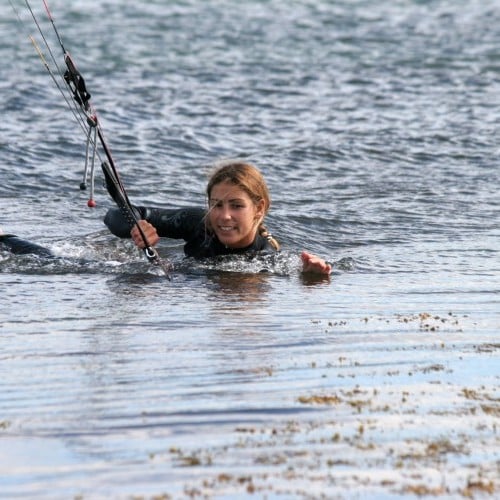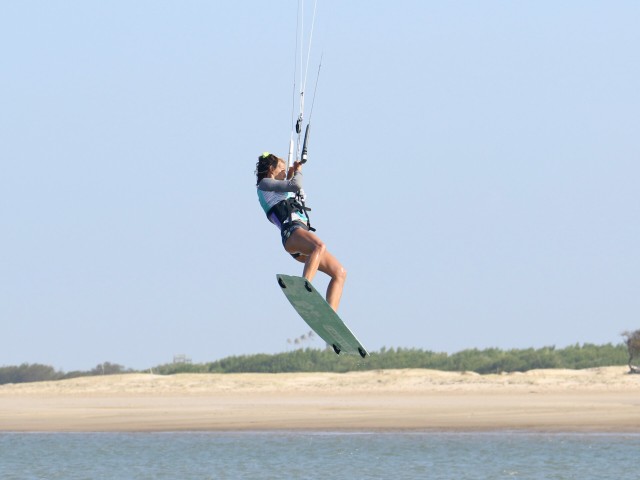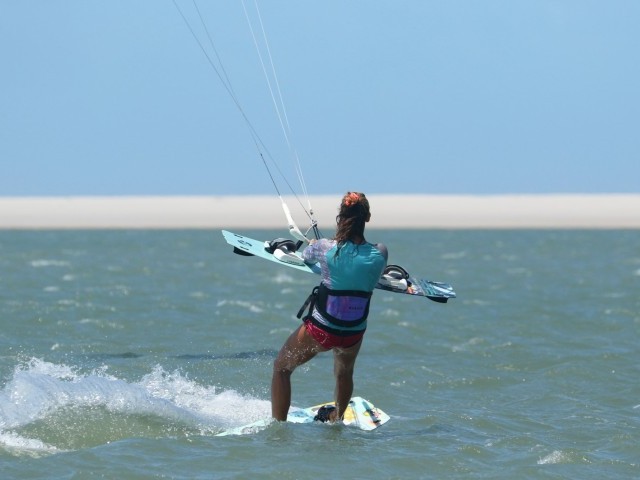
Body Dragging Upwind
Technique / Beginner
Introduction
Being able to get back to your board or back to the beach is just as important as being able to ride. Without the confidence which this skill gives you, you’ll be sentenced to a life wearing a board leash, doomed to never pushing yourself to learn anything new or fancy, and a hobby involving much more swimming and faffing than you ever thought possible.
Body dragging upwind well will not only retrieve your board from where you left it, but is doubly handy to get back in when the wind drops or changes direction, and get you out when the shore break does not seem like the most inviting spot to get your board on. No doubt you will all have covered this very ground when you had your lessons, so let’s consider this more of a recap, reminder and explanation of all the important parts of dragging upwind.
Breaking it Down
We’ll strip dragging down into three main parts. Firstly you can peruse what effect the kite has on proceedings, then ponder the significance of your heavenly body and digest how it all fits together in the real world. After that we’ll have a butchers at how to make your turns more efficient and at how to not loose your beloved board.
The Kite
The position of the kite in the window will have a direct effect on how well you can drag upwind, as it determines what you can do with you body. The principles here are pretty much identical to those of riding along on the board.
Swing High
With your kite high in the window, somewhere between 11.30 and 12.30, depending upon your direction of travel, you will be lifted up and out of the water by the kite’s lift. As the kite lifts you it will pull you slightly down wind, the direction that it is being pushed by the wind, which rather contradicts your best intentions. In Pic A you can see that with the kite high Karine has little control. Her problems here are that she cannot generate upwind momentum, and she cannot get her body into a dynamic position as the kite pulls her vertically. The outcome will be that she’ll just get dragged downwind by the kite, despite her soulless effort.
Swing Low
Flying your kite lower and nearer to the water would therefore seem like a much better option. This will however depend on the power in your kite, and your skill level. With plenty of power you can get your head down and plough through the water without having to do much. The downside to this is that it’ll be very wet, which translates to mouthfuls of water, and it is easier to loose your orientation, and therefore potentially your board.
Should the wind, and therefore the power in your kite be light, a low kite will give you little room for error. With the kite hovering just above the surface of the water, any lulls in the wind, or discrepancies in steering technique, could be punished by a dropped kite and even more downwind yardage.
Your best bet is to fly the kite between either 10 and 11.30 or 12.30 and 2 o’clock as Karine id doing in Pic B. This gives you the ability to work the kite to gain power, enables you to get a decent position in the water, allows you to tank upwind and gives you some margin for error.
Meanwhile Back at the Bar
As it is necessary to fly the kite with one hand, you need to make sure you understand where the power is. Once again you only need to pull the bar in until the back lines are tight. If this does not give you enough power you will need to work the kite by moving it up and down between the above stated times.
If you try pulling in for power in light winds, your kite will no longer fly forward towards the side edge of the window, but will stop and tumble down.
If you try pulling in too much when there is power, your kite will fly more downwind of you, and will not fly around to the side edge of the window, and therefore pull you more downwind than upwind.
However if you let the bar out too much, you’ll get no power and you won’t be able to steer the kite, so you’ll be going nowhere fast.
Your Body
The aim of your body is to generate as much resistance as possible against the kite and direct the power into upwind forward momentum. The angle that you can cut upwind will increase with practice and belief.
If you look at Pic C you can see Karine in her upwind dragging position. She has her leading arm out-stretched, pointing towards where she wants to go, and both her legs are stretched out behind her. This gives her as long an “edge” as possible. She has rolled over onto her front and is laying side on to the pull, and locks her arm and legs to resist against the pull in the kite. You can see that because the kite is not too high she is able to get into this position on her front, and because the kite is not too low she is not drowning.
Driving
In both Sequence 1 and 2 Karine has her steering hand, the back hand, butted right up against the chicken loop line. You must do this to not only control which way the kite turns but also to keep tension on the lines and therefore power in the kite.
Taking the kite back up is the easy part; you just pull down with your steering hand. However you do need to be gentle at first, because if you pull too hard and the kite goes too high or even behind you, not only will you move off downwind, but it is also very difficult to steer it back across and down with one hand.
Steering the kite down requires you to lift your elbow, but rather than push the bar, you need to turn your wrist down, as if you were opening a bottle. You can see in both sequences how Karine’s elbow lifts to push and lowers to pull.
Practicalities
To make this work you must keep your bearings, especially if the sea is wavy. The first thing you should do after a tumble is check where your board is. It’s all good and well keeping your head down and going straight into a drag, but you’re under no time pressure, so stop, take a breath and locate your board. Once you know where it is you can start dragging. If the sea is rough it may be hard to keep your face out of the drink so try and feel where you kite is flying from your harness. As you feel the kite starting to pull you up you should push the kite back down, and as you feel the power pulling you along the surface it’ll be time to take the kite back up. This way you’ll be able to save your eyes and lungs from any unwanted brine.
Obligatory Turns
If you left your board a long way upwind and it’s easy to see, perhaps after having to relaunch your kite, then long runs will get you back quicker, as it tends to be the turns that loose you ground. However if it’s hard to keep an eye on your treasured flotsam, short runs are favourable as you’re less likely to loose it again. This means your turns will have to be polished.
Changing direction is all about doing everything in slow motion. You’ll slowly take the kite up, slowly change position and slowly start off again. Any sudden and violent movements of the kite will just having you sliding back down the hill!
Following Sequence 1 & 2
- Pic 1. Karine decides to turn. At the moment she is still resisting side on lying on her front, but she slowly starts to take the kite up by pulling gently down on her left hand.
- Pics 2 & 3. The pull from the kite will come from above so Karine leans back and kicks her legs out in front of her in anticipation. This will help her fight against any downwind pull.
- Pic 4. As the kite rises towards 12 o’clock Karine lets the bar out to reduce any down wind drag. She swims back with her free hand as she kicks her legs.
- Pic 5. With the kite right above her Karine swaps hands whilst still leaning back.
- Pic 6. She can now stretch out her new leading arm and anchor it in the water as she turns to face where she intends to go.
- Pics 7 & 8. With her arm in place Karine pulls the bar down to tension her lines and steers the kite down by lifting her elbow and twisting her wrist.
- Pic 9. As the kite steers down, the power comes on and Karine can roll onto her front and make her way even further up wind.
Top Tips
Use the gentle lift when you turn to check where your board is as you’ll have a better view than when your face is ploughing through the ocean.
In Lighter winds you can kick with you legs and even try and claw upwind with you arm.
If the wind drops and you are dragging with you board, try and hold it out between you and the kite under your front arm. This technique will get you in upwind, even in light winds and is often a preferable to trying to slog back in on your board.
This technique article was in Issue 11 of IKSURFMAG.
Related
By Christian and Karine
Christian and Karine have been working together as a coaching team, running improver to advanced kitesurfing clinics since 2003.



























